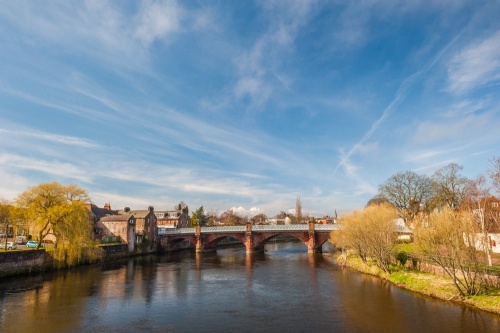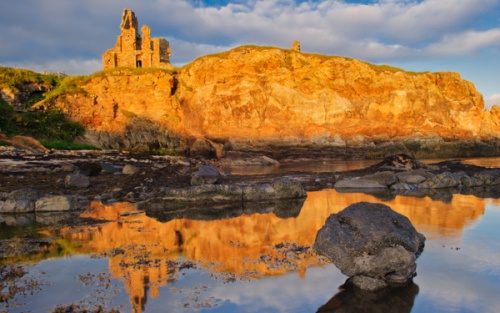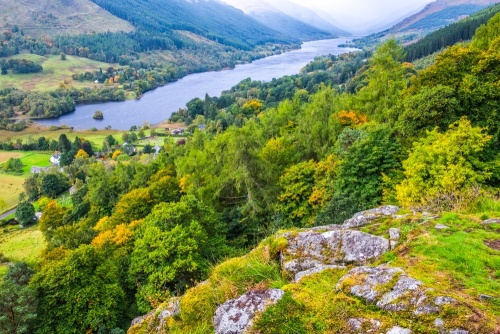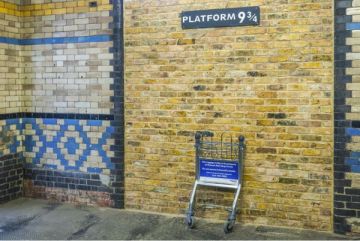It may be a cliche, but nevertheless true that Scotland has a bit of something for everyone; from the historic city of Edinburgh to the glorious unspoiled peaks of the Cuillin Hills on the Isle of Skye, there truly is something to appeal to every taste. Here we give a very brief overview of the major Scottish regions. Use this as a starting place for planning your own Scottish travels. You won't get to it all; the Britain Express family hasn't managed to get to every corner of Scotland - yet - but there is sure to be something to appeal to you no matter what your tastes.
Travelling very roughly south to north ...
Scottish Borders

The lovely rolling hills and valleys just north of the English border are home to some of the most beautiful countryside in Britain. The River Tweed runs through the heart of the region, and on its way to the North Sea the Tweed passes some of the most historic abbeys and the finest stately homes in the country. Close to the river you will find the abbeys of Melrose, Kelso, and Dryburgh, where the tomb of novelist Sir Walter Scott lies in the shadow of the medieval walls.
More about the Scottish Borders >>
Lothian

Edinburgh
The capital of Scotland, and one of the most famous historic cities in the world. The core of old Edinburgh lies between two historic buildings; the royal palace of Holyrood, and Edinburgh Castle. Between the two monuments is the Royal Mile, a warren of winding lanes and historic buildings such as the house where John Knox once lived.
Here also is Edinburgh Cathedral, and more shops selling Scottish woollens and tartan regalia than you can imagine. Edinburgh is said to be one of the most haunted cities in Europe, and if you have the stomach for it you can join one of the popular ghost tours. Princes Street is the most famous thoroughfare in Scotland, where all the smart shops - and shoppers - can be found.
More about Lothian >>
Dumfries and Galloway

Famous as a gathering place for artists and fishermen (read Dorothy L Sayers book, Five Red Herrings), Dumfries and Galloway takes in the area south of Glasgow stretching from the Solway Firth to the Firth of Clyde. At the centre of the region is the old city of Dumfries, famous for its association with Robbie Burns, who called it 'Maggie by the Banks o' Nith'.
Travel on to nearby Sweetheart Abbey, founded by Devorguilla Balliol, who also founded Balliol College, Oxford. When the good lady died in 1289 she was buried with the embalmed heart of her husband, in a silver casket. The picturesque fishing village of Kirkcudbright is famous as a centre of the arts, with schools of painting, weaving, and pottery. The Dumfries Forest Park covers 300 acres making it the largest forest park in Scotland, offering a wide range of outdoor activities for visitors.
Strathclyde
Glasgow
The largest city in Scotland, at the heart of the largest urban area in the country, Glasgow has a long history as a shipping and industrial centre. But in recent years Glasgow has done much to emphasize the arts and its architectural heritage. As a result, there is now a range of excellent museums and galleries for visitors to enjoy.
Argyll and Bute

Travel north from Glasgow along the west coast and you enter Argyll and Bute, a lovely region of sea lochs and coastal scenery mixed with high plateaus and haunting glens further inland. One of those glens is Glen Coe, famous as the site where the visiting Campbells massacred their hosts the MacDonalds in 1693. But Glen Coe offers far more than dreadful deeds to those who cross the high moors of Rannoch and descend the A87. This is one of the most spectacular nature reserves in Scotland, with superb walking to be had.
Travel west from Glen Coe to some of the most beautiful islands in Scotland. Here is Iona, where pilgrims come in their thousands to visit the shrine of St Columba. A modern monastery marks the site where missionaries from Ireland established the first Christian presence in the north of Britain in the 7th century. A short boat trip from Iona leads to Fingal's Cave on the island of Staffa, where you can see fabulous rock formations carved by centuries of wind and water action. Further south is the hill fort of Dunadd, capital of the old 6th-century kingdom of Dalriada, the first truly Scottish kingdom.
Then there is Colonsay, only eight miles long but blessed with an extraordinary abundance of scenic beauty and some of the finest beaches in Scotland.
Ayrshire and Arran
An old legend tells that when God had finished making Scotland, a few bits and dabs were left in his (her?) mighty apron. God gave the apron a flick, and these fragments fell into the sea to form Argyll and Bute. Whatever its provenance, this is one of the most spectacular regions in a country blessed with wonderful landscapes.
This is Burns Country; the poet Robbie Burns was born at Alloway, near Ayr, where the whitewashed cottage owned by his family can be visited. The Burns National Heritage Park is a starting place for visitors to explore the life and times of Scotland's most famous poet.

Travel to the Isle of Arran, which has been described as 'Scotland in Miniature', for here you will find both high peaks and lowland scenery enough for all to enjoy. Arran is a glorious island accessible by ferry from Ardrossan or Tarbert. Brodick Castle is the major recognisable attraction, but there are numerous prehistoric sites dotted about the island.
Walkers come to enjoy the challenge of Goat Fell, the highest peak in western Scotland, or the Coast Way, a circular 60-mile route that follows the coast. A short ferry journey leads to Holy Island, where a Tibetan Buddhist community runs a Peace Centre open to all.
More about Strathclyde >>
Central Scotland
Fife

The 'Kingdom of Fife' is bounded on the north by the River Tay, on the south by the Forth, and on the east by the North Sea. The area is a study in contrasts; the inland, the countryside is given over largely to agriculture, but the golden coastline is dubbed the 'Scottish Riviera' for its miles of sandy beaches. Visit the mecca of golf at St Andrews, a magnet for golfers the world over. Beyond the 'Royal and Ancient' golf club are the ruins of St Andrews Cathedral.
Stirlingshire
The city of Stirling packs more history into a small space than anywhere in Scotland. The old city walls enclose an area rife with historic buildings. The most instantly striking aspect of Stirling is the high cliff upon which the old medieval castle looks out across the Forth River valley below the city. The castle was built in the 12th century, and over the years has been a royal palace and military fortress. A few steps below the castle gates is Argyll's Lodging, a beautifully preserved 17th-century townhouse once owned by the Earl of Argyll.
The old Church of the Holy Rude is one of the few surviving medieval churches in Scotland. Here in the churchyard, you can see a gravestone bearing the marks of musket balls received during the siege of Stirling in 1650. Across the wide plain formed by the River Forth is the Wallace Monument, dedicated to William Wallace, whose military exploits at the Battle of Stirling Bridge in 1296 raised the banner of Scottish nationalism.
The Trossachs

Travel west and north from Stirling and you enter the Trossachs, a land of lochs and glens, deep valleys and striking peaks. This is Rob Roy country, the home of the 18th-century outlaw who defied English and Scottish authorities alike. Rob Roy MacGregor's tomb is in the churchyard of the old ruined kirk at Balquhidder, but reminders of his life and exploits are to be found everywhere in these hills; from Factor's Island in Loch Katrine, where he hid a captured factor of the Duke of Argyll, to Rob Roy's View, overlooking Loch Lomond at the far western end of the Trossachs. Much of the region is contained within the Queen Elizabeth Forest Park, and walking trails abound.
But there's no need to stick to dry land; take the steamship Sir Walter Scott for a journey down isolated Loch Katrine, or take a power launch from Port Menteith to Inchmahome Abbey, situated on an island in the middle of Lake Menteith - the only 'lake' in Scotland. Here the young Mary, Queen of Scots was brought for protection in 1547.
Visit Callander, the largest town in the southern Trossachs, and a centre for outdoor activity, or Killin, the northern gateway to the region, where the picturesque town is built around the Falls of Dochart. On an island in the middle of the river is the ancient burial ground of Clan MacNab. There is so much more to see, but everywhere you look, it seems, you will find the ghost of Rob Roy MacGregor, for this is his country. More about The Trossachs >>
More about Central Scotland >>
Angus and Dundee

One of the loveliest areas in Scotland, set just south of the Grampian mountains, Angus contains some of Scotland's best castles. The most famous is fairytale Glamis Castle, the former home of the Queen Mother. A royal residence since 1372, Glamis was used by Shakespeare as the setting for his play 'Macbeth'.
The shores of Angus boast some of the best golf courses in Scotland, the most famous being Carnoustie, but beyond the links stretch miles of lovely sandy beaches. Inland there are secluded glens such as Glenisla, Glenesk, and Glen Clova.
Perth and Kinross

Roughly synonymous with the old counties of Perthshire and Kinross, this area is largely agricultural in the south but rises up in the north to meet the most southerly hills of the Highlands. The most popular historic attraction in the area is Scone Palace, the ancient place of coronation of Scottish kings, and now a wonderful historic house.
In Kinross is Loch Leven, an inland loch with an ancient castle on a small island in the loch. Travel north to Perth, where you will find the palace of Scone, the very heart of Scottish nationalism. Here for centuries, Scottish rulers were crowned on the Stone of Destiny (sometimes called the Stone of Scone).
More about Tayside >>
Grampian
Aberdeen and Grampian Highlands

The old 'Granite City' of Aberdeen is the capital of the Grampian region and one of Scotland's major urban areas. In the days before oil was discovered in the North Sea, this region of Scotland depended on farming, fishing, and the textile industries. But these were but ways to feed and clothe the body; food for the soul and Scots spirit was distilled from barley, for this is whisky country, and there are distilleries offering a variety of regional drinks. Most distilleries offer visitor 'tasting tours'.
If you can still stand upright after visiting the distilleries, take in some of Grampian's castles. In no particular order are Fyvie, Leith, Dunnottar, Kildrummy, and more.
But if historic buildings aren't your cup of tea ... er ... whisky, why not take in the Highland Games at Braemar? Here you can see athletes competing in traditional Highland sports of strength and agility such as tossing the caber and listen to traditional Scottish music. Nearby is Scotland's newest national park, The Cairngorms, which is building a reputation as a winter activity centre.
More about Grampian >>
Highlands

When most visitors think of Scotland, they think of the Highlands. It's easy to see why; the sheer beauty of the Highlands is undeniable, and the romance of its history captures the imagination like no other area. From the dramatic beauty of the Scottish islands to the wilderness regions of the northern Highlands, there's an awful lot to see. Here's a breakdown of the major regions of the Highlands:
- Skye and Lochalsh - perhaps our favourite part of the Highlands
- Outer Hebrides (Western Isles)
- Inverness and Loch Ness - does a monster lurk in the depths of Loch Ness?
- The Road to the Isles - follow in the footsteps of Bonnie Prince Charlie
- Caithness - the northernmost region of mainland Scotland
- Sutherland - remote, and gloriously beautiful
- Wester Ross - marvellous mountain landscapes and coastal beauty
That's hardly even an overview, so let's find out more about The Scottish Highlands >>
You could also include Orkney and the Shetlands with the Highlands, but we'll treat them separately here:
Orkney

It is both a blessing and a curse that Orkney lies so far north, off the beaten path for most tourists. A curse because it means so few make the effort to cross the narrow stretch of water separating Orkney from the Scottish mainland, and a blessing because it remains a largely unspoiled treasure trove of spectacular coastal scenery, evocative ancient monuments, and a haven for wildlife. Here are some of the finest and justifiably famous ancient monuments in the world, such as the Stones of Stenness and the Ring of Brogar (Brodgar).
Here is the Iron Age village of Skara Brae, hidden beneath a protective layer of sand for over a thousand years. Here is the Broch of Gurness, perhaps the best-preserved broch in Scotland, and the massive chambered tomb of Midhowe, so large that it became known as the 'Ship of Death'. Here is the medieval cathedral of St Magnus in Kirkwall, where it is said the bones of the Viking martyr lie within a stone pillar.
Beside the cathedral is the medieval Bishops Palace, and a few steps away, a ruined 16th century Earl's Palace. Here are chambered cairns, like Maes Howe, where the midwinter sun aligns perfectly with the entrance and sends a shaft of light inside the mound to strike the back wall of the inner chamber.
But Orkney is not just about the past; here is some of the finest unspoiled coastal scenery anywhere. Take a walk along the spectacular cliffs at Yesnaby, where sea stacks like The Castle showcase the power and beauty of nature. Or watch for seals sunning themselves on the rocks at Birsay. If you are a birdwatcher, you've landed in heaven; no matter where you turn there are opportunities to spy gulls, skuas, fulmars, kittiwakes, razorbills, guillemots, shags, sandpipers, turnstones, dunlin, and on, and on.
I put off visiting Orkney for several years after the Britain Express family moved to the UK. I wish I hadn't waited, and I can't wait to return.
More about Orkney >>
Shetlands
The most northerly part of Scotland, Shetland is a group of islands dotted about the largest island, Mainland. The most famous attraction is Jarlshof, one of the richest archaeological sites in Britain.
Here, beside the abandoned Old House of Sumburgh, dubbed 'Jarlshof' by Sir Walter Scott, archaeologists have uncovered a site showing evidence of human occupation covering over 4000 years. Here built partly one atop the other are the remains of a Neolithic settlement, a Bronze Age smithy, an Iron Age broch, a Norse longhouse, and a medieval farmhouse.
The most famous Shetland exports are woollen garments, and you can buy hand-knitted woollens direct from the weavers themselves. The landscape is superb. but come in mid-summer and you can enjoy it practically around the clock, as the sun seldom dips below the horizon. Or come for the traditional festival of Up Helly Aa, when a Norse galley is carried through the streets of the largest city, Lerwick, and consumed on a bonfire.
More about the Shetland Islands >>




